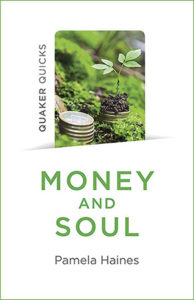Money and Soul: Quaker Faith and Practice and the Economy
Reviewed by Steve Chase
November 1, 2019
 By Pamela Haines. Christian Alternative Books, 2019. 80 pages. $10.95/paperback; $5.99/eBook.
By Pamela Haines. Christian Alternative Books, 2019. 80 pages. $10.95/paperback; $5.99/eBook.
Buy from QuakerBooks
The first sentence in the conclusion of Pamela Haines’s book Money and Soul sums up her core message to Friends today: “Faced with an economic system that lacks integrity, fosters inequality, promotes greed, encourages extraction, does violence to people and planet, and compromises community, we need to dig deep to gather the spiritual resources to respond.”
For Haines, this means “building the skills, muscles and attitudes that are needed to make our world whole.” In this short book, which is part of Christian Alternative’s Quaker Quicks series, she invites all of us to be more faithful in this effort. She asks us to give up the all too easy sins of denial, despair, and distraction, and instead cultivate the virtues of curiosity, creativity, courage, community, and compassion for self and others. This is not an easy transition. As she observes, “For many of us, it’s easier to imagine the end of the world than a new economic system—and this is a lethal failure of the imagination.”
The fundamental value of this little book is that it allows us to witness—and learn from—one Quaker woman’s personal journey to develop a moral economic outlook and informed ideas about what can be done right here, right now, to move us toward an economy that is socially just, ecologically sustainable, and spiritually fulfilling. Her story, however, is not just about one individual’s achievement. It is a story embedded in community.
Early in the book, Haines talks about how as a child and teenager she absorbed the core Quaker values of integrity, equality, simplicity, stewardship, peace, and community and then increasingly “tasted the power of applying [these] faith values to our economic story.” She also talks about being influenced by Quaker economic thinkers like John Woolman and Kenneth Boulding as well as her own father. They all served as patterns and examples for her. Haines explains about her father:
It helped me that my father was an economist, and the language of economics was in our house. I also witnessed a remarkable journey of integrity on his part. For decades he taught classical economics. His text that helped send all six of us to college was called Money and Banking. But in my teenage years I heard him questioning more and more the most basic tenets on which that theory was built, on which he had based his working life. His last decades were spent as an outspoken critic, calling the most fundamental assumptions of classical economics into question.
The heart of the book is divided into six chapters based on historic Quaker testimonies that Haines discusses and then applies as a critique of our current economic system and as a guide to alternative economic visions. Each chapter also offers some intriguing ideas for how we could start putting our time, energy, and resources into building a moral economy. Here she includes attention to what we can do “in our personal lives” and “in our wider communities.”
In the “personal lives” sections, she addresses such issues as materialism, addictions, complicity, illusions, separation, hyper-individualism, and grief, and offers examples of authentic, spiritually grounded living. In the “wider communities” sections, she includes many ideas about public policies we could support, but also gives examples of direct action campaigns to rein in corporate power. In addition, she offers many examples of what Mohandas Gandhi would call the “constructive program” of creating and nurturing alternative institutions like credit unions, B corporations, cooperatives of all kinds, land trusts, community supported agriculture, farmers’ markets, time banks, community solar, mutual aid societies, worker self-management, municipally owned utilities, tool lending libraries, and a host of other creative ideas that could be scaled up with enough effort, enabling policies and opportunities born out of emerging crises.
If I have any complaint about this inspiring little book it’s that it could do more to point to additional resources for envisioning and enacting a moral and sustainable economy. A resource section exists but does not show up in the table of contents and only includes four websites without any annotations. A more robust resource section and some discussion questions at the end of the book would have been a big help in encouraging further learning among readers.
That said, this book offers both hope and courage “to look at hard realities, to love big, to imagine a new thing that is yet unseen, and to act together with all the power at our command.” This is a great start and a worthy contribution to our search for practical faithfulness.



Comments on Friendsjournal.org may be used in the Forum of the print magazine and may be edited for length and clarity.